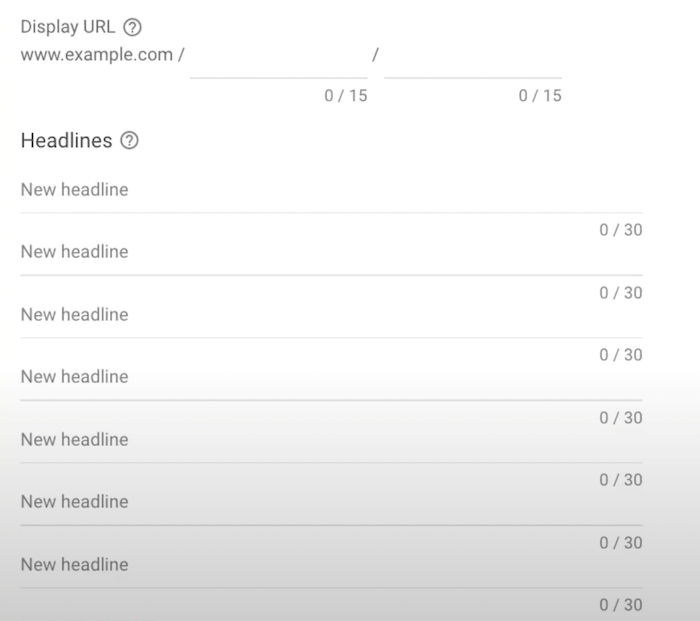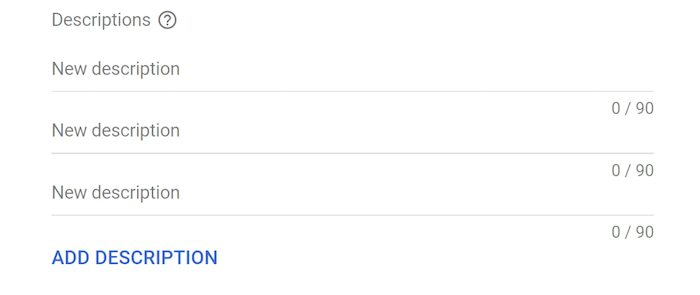
There are more ways than ever before to leverage digital AI for marketing funnel optimization, including responsive ads.
In the early stages of digital marketing, if you wanted to find out whether a piece of ad copy was effective, you had to manually A/B test your ads across locations, ages, and demographics.
This process could take months to show real results and, even then, you may not get the information you were seeking.
These days, there’s no need to waste your time testing ad copy manually.
With responsive search ads, you can use Google’s high-quality algorithms to create excellent ads that change over time to bring you the best results.
What Are Responsive Search Ads?
Responsive search ads (RSAs) allow you to automatically tailor your headlines and descriptions to determine your directed ads’ most effective pairing. This is a simple and strategic way to upgrade your automated PPC ads.
With responsive search ads, Google automatically identifies the best ad combinations while discarding ineffective ads. This means no more digging through stacks of data, comparing ad sets, and leaving your ROAS up to chance.
With responsive search ads, you can:
- Deliver the right message at the best time
- Optimize your ad process and save time
- Boost your engagement metrics with accurate reports
- Reach more customers with varied headlines that allow you to compete in more auctions and queries
Responsive search ads tend to lead to higher clickthrough rates (CTR) than regular ads. This is because they deliver relevant, tailored content and show up in more consumer searches.
How Big Are Responsive Search Ads?
Responsive search ads show more text than traditional expanded text ads and can have three headers at 30 characters each, and two separate descriptions with 90 characters each. That’s almost twice the size of regular expanded text ads.

Google offers up to 15 different headlines and four description options to help you maximize your ad potential. You can then mix these into 40,000 different options to best suit your consumer’s traits.
How to Create Responsive Search Ads
Setting up your responsive search ads can be done easily in your Google Ads account. Make sure you’re always up-to-date on Google Ad hacks to keep your ROI at its highest.
Open Your Google Ads Account
Start in your Google Ads dashboard and navigate to the left of your screen. You should see an option to use the responsive search ad creator. If you don’t see this function, you may not have access to this feature yet. Contact Google to find out what your options are.

Create Your Responsive Search Ad Headlines
Next, begin adding your headlines into the open lines. Keep in mind you are testing your copy, so make each headline unique. Too many similar headlines may not give you an accurate picture of your campaign.

It’s also important to remember that the more headlines you enter, the more chances Google has to deliver ads that best match user search terms.
Pin Relevant Headlines
You can pin your headlines by choosing the pin icon to the right of the headline. This allows you to show a headline in a specific order rather than leaving the positioning up to Google.

From here, you can choose to place your headline in the first, second, or third position. If you decide to pin only one headline, it will prevent other headlines from being used in that spot. Google recommends not using this feature unless you are a skilled ad tester, as it will impede the ability of the responsive search ad software.
Add Your Responsive Search Ad Descriptions
Google allows you to enter up to four descriptions, and it will show up to two at a time in your ads.

Like your headlines, you can pin descriptions in the first and second positions.
Remember, responsive search ads perform best with more headlines and descriptions, as they are built to test and optimize your copy. The more you give Google, the more it can give you in return.
Benefits of Responsive Search Ads
Paired with Google’s intelligent machine learning, responsive search ads can give you insights into thousands of variations of ad combinations.
With responsive search ads, Google is doing the heavy work of ad testing for you and finding the most effective content to push to your audiences. Not only does this save you time in the short term, but it also offers up a breadth of data that you can use in future campaigns.
The best part? Google does all of this for free. All you need to do is pay your regular PPC fees and let Google take over from there.
What Types of Businesses Can Benefit From Responsive Search Ads?
If you’re already running PPC Google ads and testing different copy and content variations, then you can benefit from responsive search ads.
By utilizing Google’s AI capabilities to reduce your time spent in creating and testing ads, you will be able to better focus your time on growing your business while also curating vast swaths of data that you can use in many aspects of your business.
Tips for Creating Headline and Text Variations for Responsive Ads
Although responsive search ads use machine learning to optimize your campaigns, they won’t perform well if you haven’t got the right headlines and descriptions.
Running successful responsive search ads starts with your copy. Here are a few tips for creating compelling RSA copy:
Use Unique and Varied Headlines
It’s important to create varied headlines so Google can test accurately. When writing your headlines, ensure no two headlines look alike or contain wording that is too similar.
Make sure to follow the Ad Strength meter in the upper-right of your screen to see how your headlines will perform.

There’s no need to max out your character count on every headline. As with all things digital, less is usually more. When creating your headlines, focus on your copywriting skills and write short, punchy content that will attract your audience and solidify your brand messaging.
You can also rewrite or reuse headlines from previous expanded search ads you’ve used if they performed well.
Use Keywords Sparingly
Keep your keywords in mind as you create and make sure each headline is relevant to your chosen keywords. Excellent Google Ads campaign management starts with a foundation of keyword research.
If you want to test your keywords’ effectiveness, try adding one or two headlines that don’t contain your keyword and see how they perform. You can do this with different test groups to test keyword strengths against each other.
It’s also a good idea to use dynamic keyword insertion (DKI), which allows you to tailor keywords based on user search preferences.
For example, if you’re selling winter coats, your keyword may be “jackets.” With dynamic keyword insertion, you could show your content to users looking for “winter jackets,” “rain jackets,” and even “light jackets.” This tactic improves the reach of your keyword and ensures your audience is getting the most relevant information available.
Pay Attention to Google’s Recommendations
If you haven’t started using responsive search ads yet, you may see prompts in your Google Ads dashboard asking you to get started. If you click through the prompts, you may find Google has already created some headlines and descriptions based on the information they already have about your business.
Review the recommendations and make any changes necessary. Then get to testing!
Google will also make recommendations based on your landing page copy and other ads you may be running. They won’t always be the right choice, but they often have relevant keywords and useful tips that can save you time when creating new copy.
Pin Relevant Headlines, But Don’t Overdo It
Pinning headlines and descriptions is a great way to feature relevant offers such as limited time only deals or your latest sales.
While pinning can help get important messages out to your audience, don’t overdo it. Pinning too much will inhibit Google’s machine learning abilities and stop your ads from bringing in the best data.
When you first start building your responsive search ads, we suggest not pinning anything for the first few weeks until you have a good swath of data to mull over.
Use CTAs In Your Descriptions
Your descriptions are the place to land your messaging. It’s good practice to add relevant calls-to-action in your descriptions to help guide users to the actions you want them to complete.
Think about the actions you want specific users to complete across your demographic range. For example, a brand new customer may see a “Learn More” CTA, whereas a returning customer could be offered a discount or promo code.
As with your headlines, make your descriptions unique and varied to get the most out of your testing.
Test One Responsive Search Ad Per Audience Group
Testing more than one responsive search ad per audience group can lead to inconsistent and incomplete data. Make sure you target your RSAs to specific target demographics and locations, and don’t spread yourself too thin.
If you try to speak to everyone, you could end up speaking to no one.
Conclusion
Responsive search ads can be a great way to drive more qualified leads and improve your conversion rates.
By leveraging Google’s effective machine learning software, you can cut down the time you spend testing and retesting your ads and shift your focus back to growing your business.
Remember, the more information you give Google, the more you will get back, so take the time to build strong headlines and descriptions to give your ads the best starting spot.
What kind of results have you seen with responsive search ads?
The post How to Create the Best Responsive Search Ads appeared first on Neil Patel.
About us and this blog
We are a digital marketing company with a focus on helping our customers achieve great results across several key areas.
Request a free quote
We offer professional SEO services that help websites increase their organic search score drastically in order to compete for the highest rankings even when it comes to highly competitive keywords.
Subscribe to our newsletter!
More from our blog
See all postsRecent Posts
- Web Hosting September 26, 2023
- Affiliate Management September 26, 2023
- Online Presence Analysis September 26, 2023

